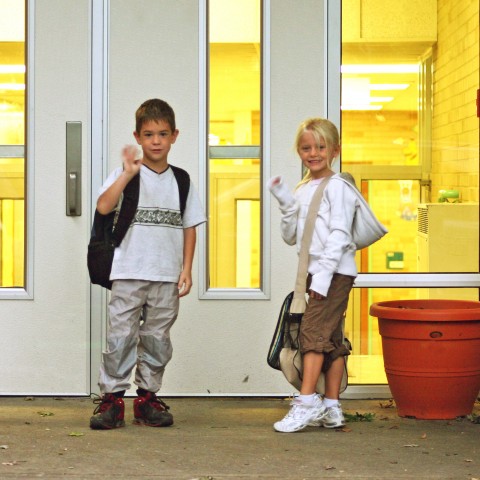
There are many different ways to say goodbye in Korean, and each expression is used in a specific context. Studying Korean goodbye phrases and when to use them is crucial in developing your speaking skills, as some phrases may be considered offensive when used in the wrong context. For example, the way you say goodbye to an elder will be different from how you say goodbye to someone your own age.
In this article, you’ll learn how to say goodbye in Korean in any circumstance. By the time you’re done reading, you’ll be one step closer to conversing like a native Korean-speaker!
Are you ready? Let’s go!
 Table of Contents
Table of Contents
- The Most Common Ways to Say Goodbye
- “I gotta go. Goodbye!” & “See you again!”
- “Goodbye, see you again.”
- Saying “Thank you, goodbye,” to Strangers
- Let’s Test Your “Goodbye” Skills
- How KoreanClass101 Can Help You with Korean
1. The Most Common Ways to Say Goodbye

As you probably know already, Korean has different politeness levels of speech. So, depending on whom you’re speaking to, you need to adjust your behavior as well as the way you talk.
Let’s say that you just bought something from a supermarket. As you leave, the cashier tells you goodbye by saying: 안녕히 가세요. (Annyeonghi gaseyo.) To reply, you would need to say: 안녕히 계세요. (Annyeonghi gyeseyo.)
Did you notice the difference? The phrase is exactly the same except for the 가 (ga) and 계 (gye).
Here’s the rule for this:
When you say goodbye to someone who is leaving, or going far from where you are, you say:
— To say goodbye in Korean when you are leaving instead, you say:
|
There are many other ways to say goodbye to someone. Let’s say that you’re at the office and want to say goodbye to your manager. The business level forms of “goodbye” are:
- 안녕히 가십시오.
(Annyeonghi gasipsio.)
“Goodbye.”
- 안녕히 계십시오.
(Annyeonghi gyesipsio.)
“Goodbye.”
Now, how would you say goodbye to your friends? Here are some informal goodbye phrases:
- 잘가!
(Jalga!)
“Bye!” [Have a safe trip back home.]
- 안녕.
(Annyeong.)
“Bye.”
Be careful when using these informal phrases, and remember that they can only be used among friends. If you say this to an elder or someone of a higher status, you’ll sound extremely offensive.
Example:
- A: 가르시아 씨, 만나서 반가웠어요.
(Gareusia ssi, mannaseo bangawosseoyo.)
“It was nice meeting you, Mr. Garcia.”
- B: 저도요.
(Jeodoyo.)
“You too.”
- A: 그럼. 안녕히 가세요.
(Geureom. Annyeonghi gaseyo.)
“Goodbye.”
- B: 네. 안녕히 계세요.
(Ne. Annyeonghi gyeseyo.)
“Goodbye.”

I gotta go. See you tonight!
2. “I gotta go. Goodbye!” & “See you again!”
Let’s say that you’re at a friend’s birthday party and you realize that the last train arrives in fifteen minutes. How would you say “I gotta go” in Korean? How would you hint that you need to leave soon?
Say one of these phrases:
| Formal: 이만 들어가볼게요. (Iman deureogabolgeyo.) – “I am afraid that I need to leave now.” Formal-casual: 저 갈게요. (Jeo galgeyo.) – “I’m going.” Formal-casual: 저 가야겠어요. (Jeo gayagesseoyo.) – “I have to run.” Informal: 가야겠다. (Gayagetda.) – “I gotta go.” |
More examples:
Formal
- 죄송하지만 이만 들어가볼게요.
(Joesonghajiman iman deureogabolgeyo.)
“I’m sorry, but I need to go.”
Casual
- 앗, 벌써 시간이 이렇게 됐네. 가야겠다.
(At, beolsseo sigani ireoke dwaenne. Gayagetda.)
“Oh. Time flies. I gotta go.”

School is over! See you tomorrow!
3. “Goodbye, see you again.”
Here, you’ll learn different ways to say: “Goodbye, see you again.”
Let’s say that you and your friend are walking together and are about to go your separate ways. In this case, you can say: 또 봐! (Ttobwa!), meaning “See you!” because you’re with your friend. Another appropriate phrase would be: 안녕 (annyeong).
Now let’s say that you’re with a business partner and are about to say goodbye. The most appropriate phrase here would be: 다음에 또 뵙겠습니다. (Daeume tto boepgetseumnida.)
With the basics covered, let’s see a few more ways to give a proper farewell in Korean at different formality levels:
- 다음에 또 봐요. [formal]
(Daeume tto bwayo.)
“Catch you later.”
- 나중에 봐요! [formal-casual]
(Najunge bwayo!)
“Later!”
- 잘가요! [formal-casual]
(Jalgayo!)
“Bye bye!”
- 우리 다음에 또 봐요!
(Uri daeume tto bwayo!)
“See you again!”
- 다음에 또 봐.
(Daeume tto bwa.)
“See you again.”
- 또 봐! [casual]
(Ttoba!)
“See you!”
More examples:
- A: 오늘 정말 즐거웠어요. 고마워요.
A: Oneul jeongmal jeulgeowosseoyo. Gomawoyo.
A: “I had so much fun today. Thank you.”
- B: 별 말씀을요. 다음에 또 봬요.
B: Byeol malsseumeuryo. Daeume tto bwaeyo.
B: “Don’t mention it. I will see you next time. ”
- A: 네. 다음에 또 봬요.
A: Ne. Daeume tto bwaeyo.
A: “I will see you next time.”
Learn about parting phrases in Korea in this dedicated lesson:

Goodbye!
4. Saying “Thank you, goodbye,” to Strangers
Let’s say that you asked where the bathroom was at the department store. A receptionist kindly explained to you where the bathroom was, and you wanted to politely say: “Thank you, goodbye.” In this case, you could say: 감사합니다. 안녕히 계세요. (gamsahabnida. annyeonghi gyeseyo.) This phrase translates as: “I appreciate it. Goodbye.”
While that phrase is grammatically correct, people rarely say it in a situation like the one above.
Instead, they’re more likely to use one of these phrases:
- 네, 알겠습니다. (감사합니다.)
[Ne, algetsseumnida. (Gamsahamnida.)]
“Okay, I understand. (Thank you.)”
- 아 네, 감사합니다.
(A ne, gamsahamnida.)
“Ah okay, thank you.”
- 좋은 하루 되세요. [common phrase in the service industry]
(Joeun haru doeseyo.)
“Have a good day.”
Example:
- A: 무엇을 도와드릴까요?
A: Mueoseul dowadeurilkkayo?
A: “How may I help you?”
- B: 저..분실물 센터는 어디에 있나요?
B: Jeo..bunsilmul senteoneun eodie innayo?
B: “Um…where is the lost and found center?”
(After you receive the information)
- B: 네, 알겠습니다. 감사합니다.
B: Ne, algetsseumnida. Gamsahamnida.
B: “Okay, I understand. Thank you.”

How do you say “Have a great day” in Korean?
5. Let’s Test Your “Goodbye” Skills
Now that you’ve read all about saying goodbye in Korean, let’s do some exercises!
Q1. You’re on a date with someone and are about to say goodbye. What’s the most appropriate way to say goodbye to your date?
- 네, 알겠습니다. 감사합니다.
(Ne, algetsseumnida. Gamsahamnida.)
“Okay, I understand. Thank you.”
- 다음에 또 봬요.
(Daeume tto bwaeyo.)
“I will see you next time.”
- 안녕히 가십시오.
(Annyeonghi gasipsio.)
“Goodbye.”
Q2. You’ve finished your grocery shopping at a supermarket near your house. The cashier in front of you says 안녕히 가세요. (annyeonghi kashipshio.), meaning “Goodbye.” How would you respond?
- 무엇을 도와드릴까요?
(Mueoseul dowadeurilkkayo?)
“How may I help you?”
- 안녕히 가십시오.
(Annyeonghi gasipsio.)
“Goodbye.”
- 안녕히 계십시오.
(Annyeonghi gyesipsio.)
“Goodbye.”
Q3. You’re at a friend’s birthday party. You realize that the last bus departs soon and you need to leave the party early or you’ll miss it. How would you let your friend know that you have to go now?
- 미안, 막차버스가 12시라서… 나 가볼께.
(Mian, makchabeoseuga yeoldusiraseo..na gabolkke.)
- 미안, 막차버스가 12시라서… 안녕히 계세요.
(Mian, makchabeoseuga yeoldusiraseo… annyeonghi gyeseyo.)
- 안녕, 막차버스가 12시라서… 좋은 하루되세요.
(Annyeong, makchabeoseuga yeoldusiraseo…joeun harudoeseyo.)
Q4. Your homestay mother is about to leave the house. How would you say “goodbye” to her politely?
- 안녕히 가세요.
(Annyeonghi gaseyo.)
- 안녕.
(Annyeong.)
- 다음에 또 봬요.
(Daeume tto bwaeyo.)
Here are the answers:
Q1: 2
Q2: 3
Q3: 3
Q4: 1
If you’re still unsure about how to say goodbye in Korean, check out these two pages on KoreanClass101.com:

Hello and goodbye!
6. How KoreanClass101 Can Help You with Korean
In this article, you learned how to say goodbye in various situations. Here’s a list of pages that you can check out in your spare time to learn more about this topic with cultural insights.
- How to Say Hello and Goodbye at Your Workplace
- Learn some ways to say “goodbye” in Korean
- Etiquette in South Korea
- Korean words and phrases
Of course, you’ll need to say “Hello” before you say “Goodbye!” Here are some useful pages on the topic:
- How to Say Hello in Korean
- 한국에서 자주 쓰이는 인사말 (hangugeseo jaju sseuineun insamal) – “Common Ways to Say Hello”
- 일반적인 작별 인사법 (ilbanjeog-n jagbyeol insabeob) – “Most Common Ways to Say Goodbye”
KoreanClass101.com is the best place to learn Korean in a fast, easy, and effective way. Create your free lifetime account today for access to numerous free features, such as themed vocabulary lists and new lessons every week. We provide you with practical information related to vocabulary, grammar, and Korean culture, so you’ll never be at a loss in your Korean learning!
When was the last time you said goodbye to someone in Korean? Before you go, leave us a comment and let us know—we would love to hear your stories.
Good luck with your Korean studies!










